What is the effect of air humidity on flowers

There are many kinds of flowers, and the requirements for air humidity are also different due to the different climatic conditions of the place of origin. If the air humidity is too large, it is easy to make branches and leaves grow, petals moldy, falling flowers, and easy to cause the spread of diseases and insect pests. The humidity during flowering is too high, which hinders flowering and affects fruiting. The air humidity is too low, the florescence is shortened, and the flower color becomes lighter. If the air is dry for a long time, it will grow badly and affect flowering and fruiting. Northern winter climate is dry, indoor flower cultivation, such as do not often maintain a certain humidity, some like moist flowers, often appear leaf color yellowish, leaf edge dry and so on. For flowers that like shade and dampness, if they are cultivated in a dry environment for a long time, the leaves will turn yellow or red, become small, thin and curly, or the leaves will be dry and scorched; flowers that like drought will easily become thinner if they are kept in a humid environment for a long time, such as the epidermis of cacti. And rot will occur. In cultivation, it is usually divided into three categories according to the requirements of flowers for air humidity.
1. Flowers that like shade and dampness, such as begonia, hairpin, orchid, fern, taro, rhododendron, etc., require that the air relative humidity is often maintained at 60 {bf} ~ 80 {bf}.
2. Drought-tolerant flowers such as cactus, cactus, tequila, etc. In North China, the general indoor air humidity is fine.
3. The air humidity requirements of neutral flowers are between the first two, such as Magnolia, Milan, jasmine, Michelia, Fusang, Pueraria lobata, citrus, palm, sweet-scented osmanthus and so on.
The air humidity in spring and autumn in the north is very low, which is not suitable for the growth and development of flowers in the south. Indoor heating with a stove in winter is more disadvantageous to wet flowers. In order to raise the flowers well, we can find ways to adjust the air humidity in the small environment. For example, spray washing branches and leaves or covering with plastic film and other methods to increase air humidity and create humidity conditions suitable for flower growth. Orchids, begonias, ferns and other humid flowers require that the relative humidity of the air is not less than 80 {bf}, and that of medium-wet flowers such as jasmine, white orchids and mulberries is not less than 60 {bf}.
Related
- What if the leaves of potted flowers turn yellow?
- Florescence Control of several Flowers
- Anti-freezing technology and post-freezing nursing technology of flowers
- What is the classification of flowers? What are the common methods of flower classification?
- Prevention and control of alkali and acid damage of flowers in courtyard
- Technology of Anti-freezing and restoring growth of Flower seedlings in greenhouse and greenhouse
- How does flower fertilization not hurt the root? Fertilization technology of flowers
- Key points of disinfection in flower greenhouse
- Several pesticides that are banned or used cautiously in flowers
- How to fertilize the flowers that watch the leaves?



